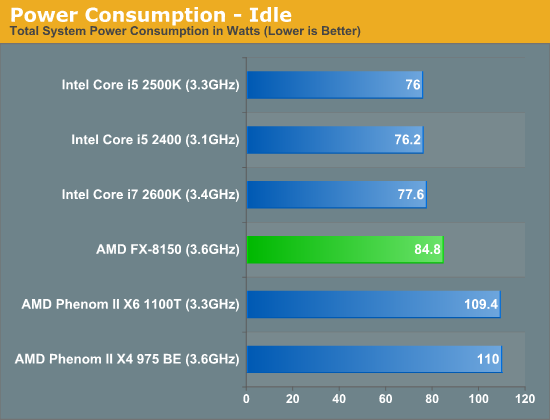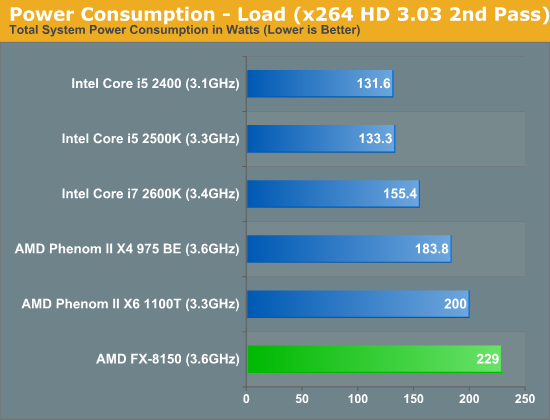The Bulldozer Review: AMD FX-8150 Tested
by Anand Lal Shimpi on October 12, 2011 1:27 AM ESTPower Consumption
Performing cross-platform power consumption comparisons is difficult simply because there is a lot of variance between motherboards. Looking at the AMD family alone to start with, the FX-8150's additional power and clock gating really pays off as Bulldozer idles at a significantly lower power level than the Phenom IIs. Sandy Bridge still appears to be a bit cooler.

Under load however, Bulldozer consumes quite a bit of power easily outpacing the Phenom II X6:

I suppose Global's 32nm process in combination with Bulldozer's high frequency targets are to blame here.










430 Comments
View All Comments
nofumble62 - Thursday, October 13, 2011 - link
Crappy building block will mean crappy building.richaron - Friday, October 14, 2011 - link
At first I was pissed off by being strung along for this pile of tripe. After sleeping on it, I am not completely giving up on this SERVER CHIP:1) FX is a performance moniker, scratch stupid amount of cache & crank clock
2) I'm sure these numbties can get single thread up to thuban levels
3) Patch windows scheduler ffs
Fix those (relatively simple) things & it will kick ass. But it means most enthusiasts wont be spending money on AMD for a while yet.
7Enigma - Friday, October 14, 2011 - link
Biggest problem for a server chip is the load power levels. It just doesn't compete on that benchmark and one in which is VERY important for a server environment from a cost/heat standpoint.Let's hope that's just a crappy leaky chip due to manufacturing but it's to early to tell.
richaron - Friday, October 14, 2011 - link
I've worked in a 'server environment'. of course power consumption is an issue. at the lower clock speeds & considering multithread performance, this is already a good/great contender. virtual servers & scientific computing this is already a winnar.with a few (hardware & software) tweaks it could be a GREAT pc chip in the long term.
ryansh - Friday, October 14, 2011 - link
Anyone have a BETA copy of WIN8 to see if BD's performance increases like AMD says it will.silverblue - Friday, October 14, 2011 - link
There's benchmarks here and there but nothing to say it'll improve performance more than 10% across the board. In any case, the competition also benefits from Windows 8, so it's still not a sign of AMD closing any sort of gap in a tangible fashion.Pipperox - Friday, October 14, 2011 - link
But Bulldozer is different.Windows 7 scheduler does not have a clue about its "modules" and "cores".
So for example it may find it perfectly legit to schedule 2 FP intensive threads to the same module.
Instead this will result in reduced performance on Bulldozer.
Also one may want to schedule two integer threads which share the same memory space to the same module, instead of 2 different modules.
This way the two threads can share the same L2 cache, instead of having to go to the L3 which would increase latency.
All of the above does not apply to Thuban; to a lesser degree it applies to Sandy Bridge, but Windows 7 scheduler is already aware of Sandy Bridge's architecture.
nirmv - Saturday, October 15, 2011 - link
Pipperox, It's not different than Intel's Hyper Threading.Pipperox - Sunday, October 16, 2011 - link
It is, although they're similar concepts.Let's make an example: you have 2 integer threads working on the same address space (for example two parallel threads working in the same process).
All cores are idle.
What is the best scheduling for a Hyperthreading cpu?
You schedule each thread to a different core, so that they can enjoy full execution resources.
What is best on Bulldozer?
You schedule them to the SAME module.
This because the execution resources are split in a BD module, so there would be no advantage to schedule the threads to different modules.
HOWEVER if the 2 threads are on the same module, they can share the L2 cache instead of the L3 cache on BD, so they enjoy lower memory latency and higher bandwidth.
There are cases where the above is not true, of course.
But my example shows that optimal scheduling for Hyperthreading can be SUB-optimal on Bulldozer.
Hence the need for a Bulldozer-aware scheduler in Windows 8.
Regs - Friday, October 14, 2011 - link
AMD needs a 40-50% performance gain and they're not going to see it using windows 8. What AMD needs is...actually I have no clue what the need. I've never been so dumbfounded about a product that makes no sense or has any position in the market.